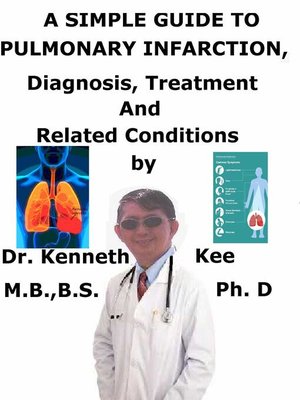A Simple Guide to Pulmonary Infarction, Diagnosis, Treatment and Related Conditions
ebook
By Kenneth Kee

Sign up to save your library
With an OverDrive account, you can save your favorite libraries for at-a-glance information about availability. Find out more about OverDrive accounts.
Find this title in Libby, the library reading app by OverDrive.



Search for a digital library with this title
Title found at these libraries:
| Library Name | Distance |
|---|---|
| Loading... |
This book describes Pulmonary Infarction, Diagnosis and Treatment and Related Diseases
An infarction is the death of the body tissue.
A myocardial infarction indicates the death of some heart muscle tissues causing a heart attack.
A Pulmonary Infarction or Lung Infarction happens when a segment of lung tissue dies when its blood supply has become blocked.
Death of one or more segments of the lung tissue caused by deficiency in blood supply is termed pulmonary infarction or lung infarction.
The segment of tissue, which is dead, is known as a lung infarct.
While several medical disorders can produce a pulmonary infarction, the most frequent cause is pulmonary embolus.
The cause of deficit or reduced blood flow is normally an obstruction in a blood vessel which supplies the lung.
The obstruction may be in a type of a blood clot or air bubbles in the bloodstream (embolism).
The blockage could also be from a blood clot which has developed in the blood vessel itself and continues to stay at the site where it was formed.
This form of clot is termed a thrombus.
Normally in healthy lungs, these blockages do not produce death of the tissue as the blood arrives at its destination through alternative routes.
If the lungs are not healthy, i.e. if they are infected, congested or has insufficient air supply, then lung infarctions can happen after the blockage of a blood vessel.
Depending on its size and site, the symptoms of a pulmonary infarction can vary from person to person, from being quite mild to excessively severe.
Whatever its symptoms, when a pulmonary infarction happens it always indicates that there is a serious underlying medical disorder, and intensive evaluation and treatment is needed.
Infarcts may take up to 2 to 3 weeks to recover where the dead tissue is replaced by scar tissue.
The most frequent cause of pulmonary infarction is from a pulmonary embolus.
It is now evaluated that up to 30% of pulmonary emboli cause at least a small pulmonary infarction.
Deficiency or reduced blood flow is caused by obstruction in a blood vessel supplying lungs.
The obstruction could be a blood clot, air bubbles in the bloodstream (embolism), clot which has formed in the blood vessel itself and persists to stay at the site where it was formed (thrombus).
Several other medical disorders can also produce a pulmonary infarction by causing occlusion of part of the pulmonary circulation, blocking off blood flow to a section of lung tissue.
These causes are:
1. Cancer,
2. Autoimmune diseases e.g., lupus, sickle cell disease,
3. Infiltrative lung diseases e.g., amyloidosis,
4. Embolization of air or other materials (drug abuse) from an intravenous catheter.
Whatever the cause, very large pulmonary infarctions are comparatively rare, since lung tissue has 3 possible sources for oxygen:
1.The pulmonary artery,
2.The bronchial artery
3.The alveoli
Multiple studies indicate a severe predominance of pulmonary infarction in the lower lobes compared to the upper lobes
Symptoms may be:
1. Hemoptysis
2. Severe dyspnea
3. Fever
4. Chest pain
CT findings of pulmonary infarction are a feeding vessel or "vessel sign," central lucency, and a semicircular shape.
The treatment comprises early cardiopulmonary support with:
Anticoagulants
Thrombolysis
Mechanical ventilation
Packed RBC transfusion
Surgery may be necessary and comprises embolectomy and surgical placement of vena caval filters
TABLE OF CONTENT
Introduction
Chapter 1 Pulmonary Infarction
Chapter 2...







